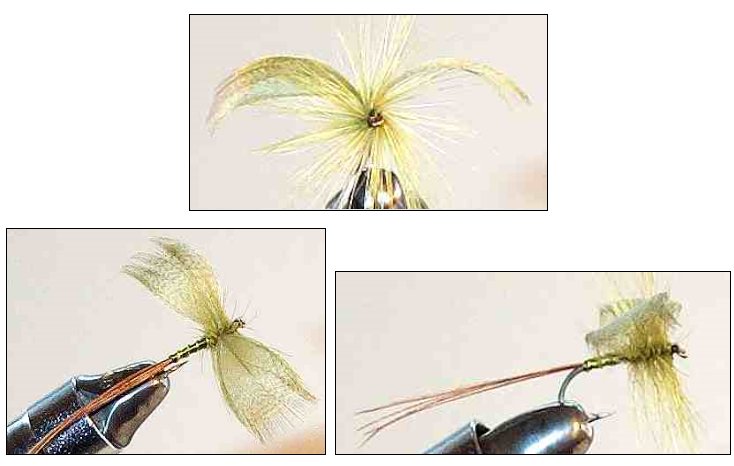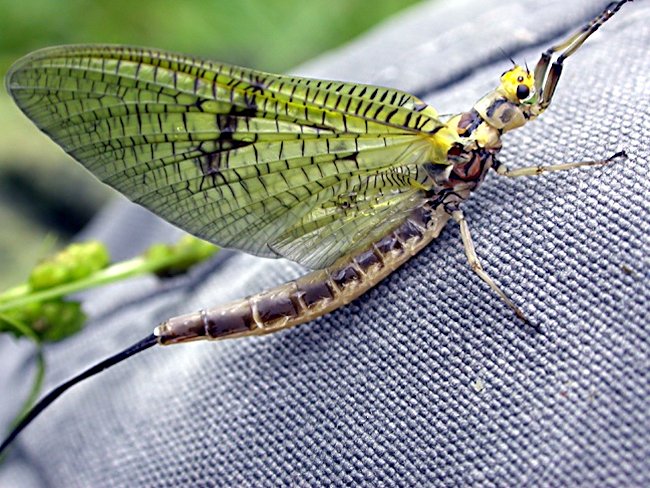The Green Drake Mayfly Spinner
In some places the Green Drake hatches only last five to eight days, but in other areas they last much longer. Large concentrations are rarely seen on the water.

FANWING MAYFLY SPINNER DRY FLY PATTERNS. Hook size 12 16 - $US each
The Green Drake Mayfly
They emerge sporadically but the trout and bass know it is a Green Drake hatch time. Drift a Green Drake fly over a quiet pool in the early evening and see what happens. Be ready to set the hook.
I have been lucky to fish a number of chalk stream rivers that have hatches of the Ephemera dancia mayfly. To you and me that is a Green Drake. I have been on the river in late May when the air above the river is alive with clouds of fluttering mayflies. In the fading light at the end of the day during the hatch you can almost hear the slurping sound of the grayling and trout taking their fill from the floating duns they find on the surface. I cast across the river or stream, rather short, and then pull the rod back to correct the drift so that the fly floats downstream towards the feeding fish in a drag free dead drift.

I find the longer the drift the better as it gives the grayling and trout longer to see the fly. In clear water you can often see them follow the fly for a short distance to check it is okay to eat before a swift seizure. That is why it is so important not to have any drag on your line that produces any un-natural disturbance in the water surface that will spook the fish. I normally find that as the season continues the smaller hook sizes are needed. I am not too sure why that happens. You would think that as these insects have had longer to feed on the bottom as a nymph they would be a bigger adult dun but that is not so. Be prepared to have smaller hook sized Green Drake mayfly fly patterns if you are fishing in June or July.
The Green Dun Mayfly
There is a species of mayfly that prefers rough water of highland mountainous areas and near rocky coastal areas. It is the Ecdyonurus insignis mayfly; its common name is the Green Dun. The dun and spinner version of this mayfly both have an olive green body. The hatches of this insect normally occur after the main mayfly hatches have finished. They emerge in mid-June and continue until mid-August. The Ecdyonurid nymph is a stone crawler and has sturdy powerful legs. It has a broad flattened tapering body. They are very evident in slack waters where a stream meets the edge of a river. I have watched them scuttling over the shingle and when I have dislodged a boulder I have found them clinging on to the rock. When the force of the river current increase during a spate after a rain storm, they are washed away downstream. Many of them are mopped up by hungry trout. I use pheasant tail nymphs to imitate this green dun nymphal stage as I find the Gold Ribbed Hares Ear nymph too chunky to match the flat body shape of this insect.
Interestingly the Green Dun upwinged mayfly hatches in to distinctly different ways depending on local conditions. Like most mayflies its nymphs rise to the water surface and float in the film as their wings dry before flying off to rest on nearby bushes, and tree. Others leave the water by crawling onto boulders and riverside vegetation where they hatch out of their nymphal shucks. In the first mode of emergence the trout can feed on the rising nymphs under the water and the drifting hatching duns on the surface; in the second, neither stage is available for the trout to feed upon.
Both are available as fish food when the females return to the water to lay eggs and when the spinners fall to the water surface after mating and egg laying has exhausted them. This normally starts to occur late in the afternoon with peak activity from about one hour before sunset into the dark. Green dun spinner falls can be huge and provide a feeding frenzy for the waiting trout. Cast upstream of the feeding zone and let your Green Drake spinner mayfly gently dead drift over the waiting fish. Be careful not to let your line cause any drag as the ripples it will cause on the water surface will spook the trout.
The Large Dark Olive Mayfly
The word "Olive" is used by fly fishermen as a term that describes lots of different upwinged mayfly species. Most only have two long thin tails in their adult form. They nearly all belong to the Baëtis group of flies. These olive mayfly dun's normally have light grey wings but as you would expect, an olive body
Fly Fishing Tips
Don't worry if your cast fails to land your fly standing on the hackles. On windy days many duns that have just emerged fall over onto their sides. Some are able to right themselves. Many don't have the energy and drown. They are slurped down by waiting hungry trout. Just float your fly over a surface feeding trout and be ready for the take. Don't tighten too early. Wait until the trout's head goes down. I always try to pick a place on the river bank upstream form the feeding fish. Trout can be spooked if they see too much leader on the water surface. If you let the fly float down stream the trout will see your fly first and not your leader.
An extract from a fishing Diary
Trout can be strange. I experienced my first Green Drake mayfly hatch on the evening of the 20th May...they are huge flies! They were everywhere, I was grabbing them with my hands and taking a good close look at them. There were also several other flies hatching too. The funny thing is that the fish never fed on them on the surface. I fished from 6pm till dark and only saw two rises all evening. I tried a few different dries and a few nymphs with no luck. Finally caught a small brown on a black woolly bugger with a bit of flash in it’s tail. We had had a good bit of rain the last couple of days and I think that was why the fish were kind of screwed-up. The next day every fish I showed a dun mayfly to went on the attack. The cloud cover gave me a 6 hour hatch, with the duns coming off the water all afternoon long. I never did see a spinner fall, evening weather was a little strange. On the third day of my long weekend fishing trip the fish were nailing emergers during the heavier rain, and dries during the calms. I got soaked, but got some beautiful trout in between soakings.
FACEBOOK COMMENT
Once the bugs appeared on the water last night the fish took interest . Took five sweet Catskill browns for an epic night of fishing . All fish were caught on a Green Drake. What a great evening on the water everything was perfect !It doesn't get any better than this , this is what keeps me coming back year after year. A great evening I will remember for the rest of my life ! - Jason Vogel, PA, USA
CUSTOMER'S COMMENT
I fish the Pequest River in New Jersey. It is the stretch that flows from the spillway that leaves the Pequest hatchery. The top trout catching dry flies are your Green Drakes for about one week when the hatch is on. Tight Lines Dude, Fred Ungaretta NJ,USA


Fly Fishing books

